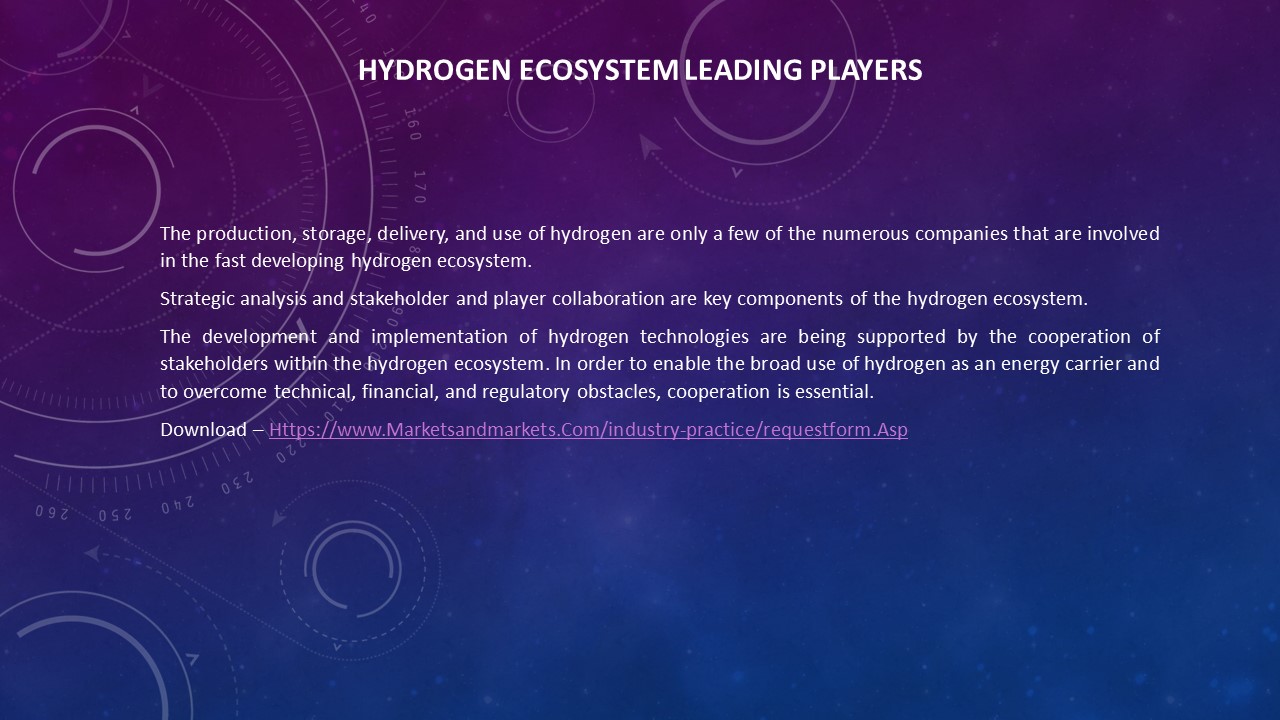Hydrogen Ecosystem Leading Players (1) - PowerPoint PPT Presentation
Title:
Hydrogen Ecosystem Leading Players (1)
Description:
The production, storage, delivery, and use of hydrogen are only a few of the numerous companies that are involved in the fast developing hydrogen ecosystem. Strategic analysis and stakeholder and player collaboration are key components of the hydrogen ecosystem. Read More - – PowerPoint PPT presentation
Number of Views:1
Title: Hydrogen Ecosystem Leading Players (1)
1
Hydrogen Ecosystem Leading Players
- The production, storage, delivery, and use of
hydrogen are only a few of the numerous companies
that are involved in the fast developing hydrogen
ecosystem. - Strategic analysis and stakeholder and player
collaboration are key components of the hydrogen
ecosystem. - The development and implementation of hydrogen
technologies are being supported by the
cooperation of stakeholders within the hydrogen
ecosystem. In order to enable the broad use of
hydrogen as an energy carrier and to overcome
technical, financial, and regulatory obstacles,
cooperation is essential. - Download Https//www.Marketsandmarkets.Com/indus
try-practice/requestform.Asp
2
- The following are some typical tactics and
projects that top players employ - Public-Private Partnerships
- Research and Development (RD) Collaboration
Governmental agencies, academic institutions, and
industry partners usually collaborate in
cooperative research and development (RD)
projects to grow hydrogen technology. These
collaborations increase technology, cost
reductions, and information sharing. Examples of
coalitions that support and encourage the
commercialization of hydrogen include the
Hydrogen Council, which brings together major
companies from many industries. - Demonstration Projects Collaborating on
demonstration projects showcases the practicality
and benefits of hydrogen technologies. Numerous
parties, including infrastructure providers,
technology developers, and end users, are
involved in these endeavors. Technology
performance validation, optimization opportunity
identification, and the development of investor
and policymaker confidence are all aided by
demonstrations. - Supply Chain Collaboration
- Value Chain Integration Stakeholders at every
stage of the hydrogen value chain collaborate to
guarantee a smooth and efficient flow of hydrogen
from production to final use. This collaboration
requires coordination between hydrogen producers,
storage providers, distributors, and end users in
order to establish seamless supply chain
networks. - Hydrogen Clusters and Hubs Collaboration is
encouraged by the development of hydrogen hubs
and clusters, which bring together several
stakeholders from different industries to
construct an ecosystem for the production,
storage, transportation, and utilization of
hydrogen. Utilizing shared infrastructure,
sharing expertise, and resource optimization are
all made feasible by these clusters.
3
- Regulatory and Policy Advocacy
- Industry Associations and Advocacy Groups
Prominent individuals often associate with
advocacy organizations and trade associations to
advance legislation and policies that support
hydrogen utilization. To develop laws, secure
financing, and promote the expansion of hydrogen
markets and infrastructure, these organizations
work closely with governments. - Policy Dialogue Platforms Stakeholders
participate in policy discourse forums at the
regional, national, and international levels.
These forums bring together industry
representatives, legislators, and regulators to
talk about and handle regulatory obstacles,
standardization, and policy harmonization. - Cross-Sector Collaboration
- Collaborative Projects with Energy Sectors The
hydrogen business needs to collaborate closely
with the natural gas, renewable energy, and power
grid industries. Combining hydrogen production
with renewable energy sources like solar and wind
power may be beneficial. Hydrogen mixing or
pipeline repurposing can be facilitated by
working with natural gas pipes that are already
in place. Working with power grid operators
enables the integration of hydrogen-based energy
systems. - Partnerships with Automotive and Mobility
Companies To enable fleet deployments,
demonstrate the viability of hydrogen-powered
transportation, and supply the essential
refueling infrastructure, manufacturers of
hydrogen fuel cell vehicles, automakers, and
mobility companies collaborate with hydrogen
producers and infrastructure suppliers. The
objective of these collaborations is to hasten
the adoption of hydrogen as a fuel for vehicles.
4
- International Collaboration
- Global Cooperation Stakeholders collaborate
worldwide to exchange knowledge, best practices,
and firsthand accounts. This involves sharing
scientific discoveries, proposed policies, and
innovative technology in order to promote the
broad use of hydrogen technologies. International
Partnership for Hydrogen and Fuel Cells in the
Economy (IPHE) and similar platforms enable
global cooperation and knowledge exchange. - Cross-Border Hydrogen Trade Stakeholders take
into account global collaborations for the trade
of hydrogen while making use of regional
advantages and resources. Initiatives like the
Australian-Japanese Hydrogen Cooperation and the
European Clean Hydrogen Alliance enable
international trade in hydrogen and the
development of international supply chains. - Read More - https//www.marketsandmarkets.com/indu
stry-practice/hydrogen/hydrogen-ecosystem-players































